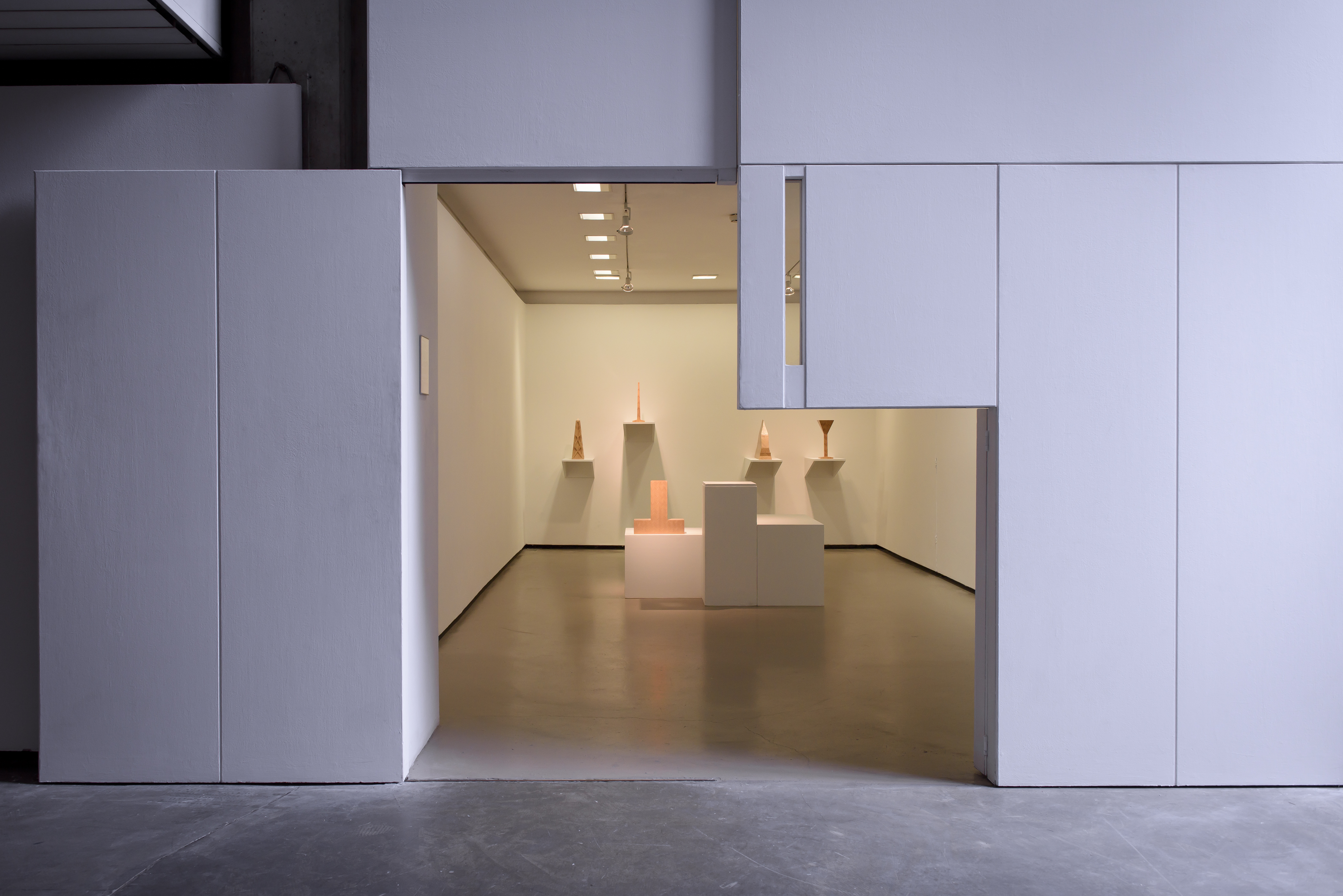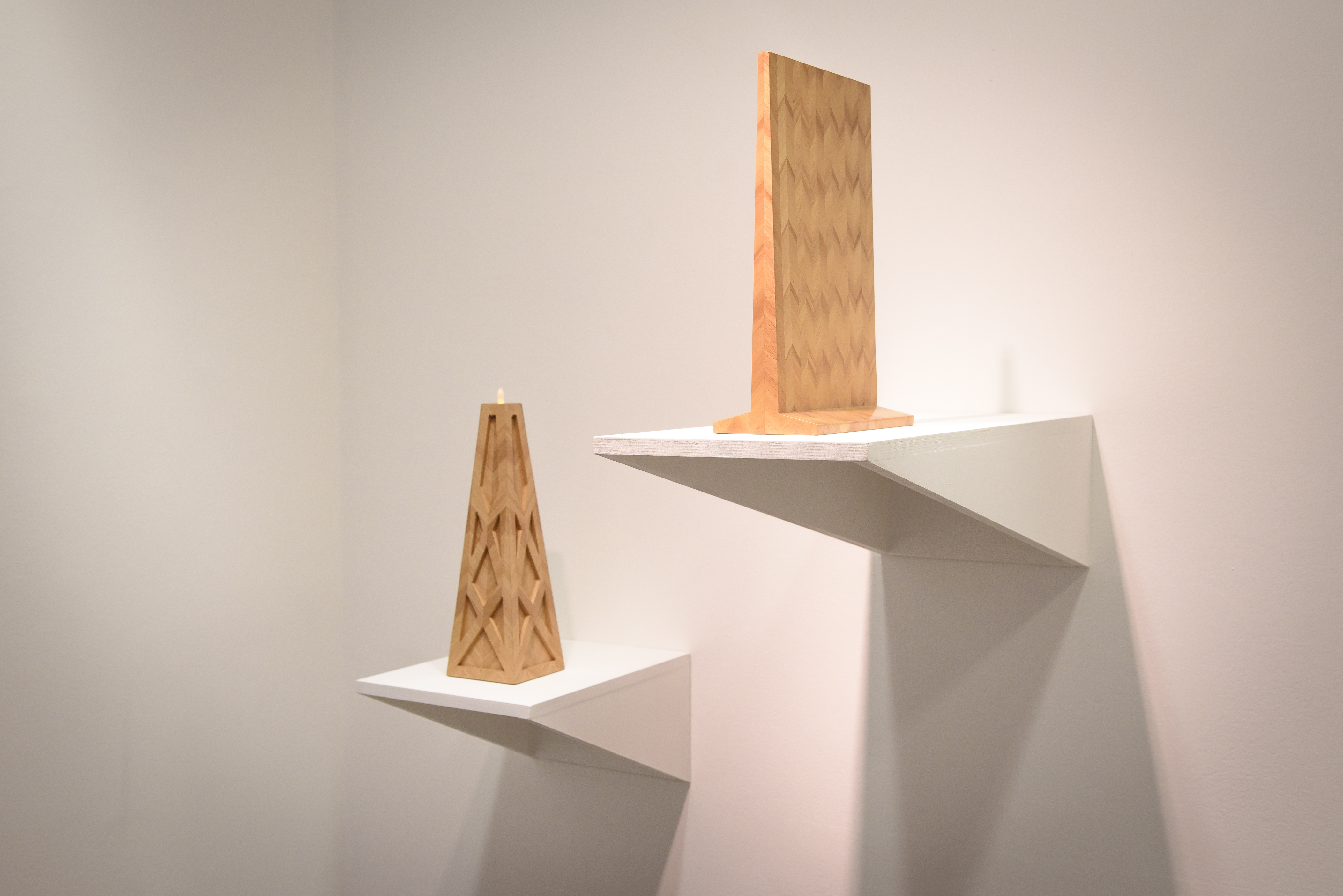Why Should Fear Seize the Limbs Before the Warning Sounds?

Why Should Fear Seize the Limbs Before the Warning Sounds? (2014–2018), commemorates figurative fires, appropriating symbols from the 1992 Barcelona Olympics and both Gulf Wars (1990–1991, 2003–2011). As in much of the artist’s work, the actors and witnesses of history are not human players; rather, they are comprised of the materials, architectures and practices intentionally or inadvertently constructed or destroyed by human actions.
Five wooden sculptures recall the rigidity of statuary. While the layered sources from which they borrow are associated with monumentality, the five forms – conjuring a torch, a concrete barricade, an oil rig, a mountain and a podium with a trapdoor – are figureless and small in scale. Fire is the main trans-historical narrative motor here, a fire only momentarily contained, only partially domesticated, but repeatedly mobilised, since its theft from the heights of Mount Olympus, to its unleashing on the oil fields of Kuwait, and the onslaught of fire power in the Shock and Awe bombardment of Baghdad.
Why Should Fear Seize the Limbs… ? is part of Six-Shooter Lessons (2009–ongoing), a multi-part project which centres on the ‘Dream Team’. In the first post-Soviet-era Olympic games in 1992, this group of superstar basketball players swept away all opposition, going on to win the gold medal for the USA. The team’s victory coincided with, and reflected, a new era of global politics, with the USA as hegemon. Aivazian’s research draws parallels between American aggressions in the Gulf Wars on one hand, and participation in the Olympics on the other, exploring the layering of violence that occurs in the passing of the torch, both literal and metaphorical, from term to term in the four year increments that make up both the presidential and Olympic cycles.
Materially, Why Should Fear Seize the Limbs…? continues Aivazian’s examination of craft, a lineage of know-how invariably impacted by the turbulence of modernity. Within the exhibition, marquetry – commonly associated with backgammon, a luck and strategy board game ubiquitous in Middle Eastern cafés, homes and other spaces where televised discussion of the Gulf Wars would form an aural backdrop – renders rigid forms of statuary systematised by ancient and recent imperial regimes, with surfaces that mimic the luscious hardwood floors of high-end basketball courts.
The title, Why Should Fear Seize the Limbs When the Warning Sounds?, is based on Virgil’s epic the Aeneid, which recounts the tales of the foundation of the Roman Empire, its wars, its heroes and its gods.
Five wooden sculptures recall the rigidity of statuary. While the layered sources from which they borrow are associated with monumentality, the five forms – conjuring a torch, a concrete barricade, an oil rig, a mountain and a podium with a trapdoor – are figureless and small in scale. Fire is the main trans-historical narrative motor here, a fire only momentarily contained, only partially domesticated, but repeatedly mobilised, since its theft from the heights of Mount Olympus, to its unleashing on the oil fields of Kuwait, and the onslaught of fire power in the Shock and Awe bombardment of Baghdad.
Why Should Fear Seize the Limbs… ? is part of Six-Shooter Lessons (2009–ongoing), a multi-part project which centres on the ‘Dream Team’. In the first post-Soviet-era Olympic games in 1992, this group of superstar basketball players swept away all opposition, going on to win the gold medal for the USA. The team’s victory coincided with, and reflected, a new era of global politics, with the USA as hegemon. Aivazian’s research draws parallels between American aggressions in the Gulf Wars on one hand, and participation in the Olympics on the other, exploring the layering of violence that occurs in the passing of the torch, both literal and metaphorical, from term to term in the four year increments that make up both the presidential and Olympic cycles.
Materially, Why Should Fear Seize the Limbs…? continues Aivazian’s examination of craft, a lineage of know-how invariably impacted by the turbulence of modernity. Within the exhibition, marquetry – commonly associated with backgammon, a luck and strategy board game ubiquitous in Middle Eastern cafés, homes and other spaces where televised discussion of the Gulf Wars would form an aural backdrop – renders rigid forms of statuary systematised by ancient and recent imperial regimes, with surfaces that mimic the luscious hardwood floors of high-end basketball courts.
The title, Why Should Fear Seize the Limbs When the Warning Sounds?, is based on Virgil’s epic the Aeneid, which recounts the tales of the foundation of the Roman Empire, its wars, its heroes and its gods.
Douglas Hyde Gallery (G2), Dublin, IRL





